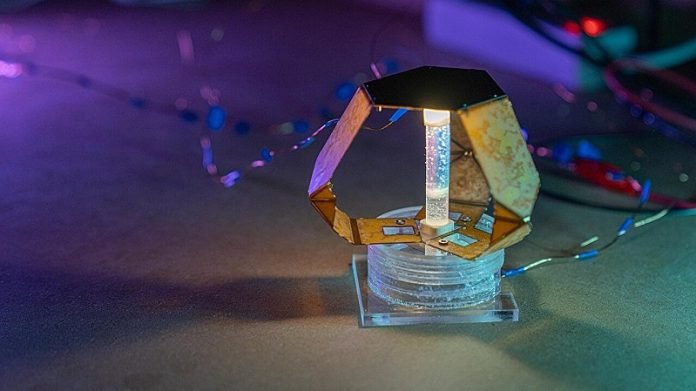
Researchers at EPFL (École Polytechnique Fédérale de Lausanne) have taken a significant step forward in the field of soft robotics and wearable technology.
They’ve created a unique sensor, called ChromoSense, which uses color to detect a range of stimuli like bending, stretching, compression, and temperature changes – much like human skin does.
Traditional sensors in robotics can sense changes in position, pressure, and temperature, which are crucial for wearable devices and human-robot interactions.
However, a key aspect of human perception is the ability to feel multiple things simultaneously, a feat that has been challenging for robotics.
Jamie Paik and her team in the Reconfigurable Robotics Lab (RRL) at EPFL’s School of Engineering have made a breakthrough in this area with their new invention.
ChromoSense is a clever and straightforward device. It looks like a small, translucent rubber cylinder and contains three sections, each dyed a different color: red, green, and blue.
An LED at the top shines light through it.
As the sensor bends or stretches, the light’s path through these colored sections changes. A miniaturized spectral meter at the bottom of the cylinder picks up these changes.
Paik explains this concept with a fun analogy. It’s like drinking three different flavors of slushie through three straws simultaneously.
If you twist or bend the straws, the mix of flavors you taste changes. Similarly, ChromoSense detects changes in light as the sensor’s shape changes.
An additional feature of ChromoSense is its ability to sense temperature changes. This is achieved through a special dye in the device that changes color with temperature, similar to the material used in color-changing t-shirts or mood rings.
This innovative research has been published in Nature Communications and has been highlighted by the journal’s editors.
One of the significant advantages of ChromoSense is its streamlined approach. While other robotic technologies use cameras or multiple sensors, which can be heavy and require a lot of data processing, ChromoSense offers a lighter, more targeted solution.
This makes it ideal for embedding into different materials for various tasks, such as in wearable devices.
ChromoSense could be a game-changer in applications ranging from assistive technologies, like exosuits that help with mobility, to everyday uses in athletic gear or clothing. These could provide feedback on a user’s movements and form.
Despite its strengths, the team recognizes a challenge: separating multiple stimuli that are applied at the same time.
They are currently working on enhancing the sensor to accurately detect local forces or specific shape changes in materials.
Paik is excited about the potential of ChromoSense and is considering different forms for it. Although currently in a cylindrical shape and part of a wearable exosuit, it could also be adapted into a flat form, suitable for origami robots, another area of focus for the RRL.
Paik summarizes the potential of this technology by saying, “With our technology, anything can become a sensor as long as light can pass through it.”
This opens up a world of possibilities for the future of robotics and wearable technology, making devices more intuitive and responsive to human needs.



